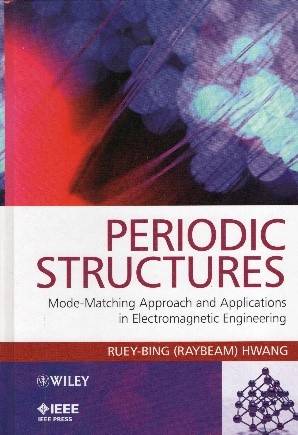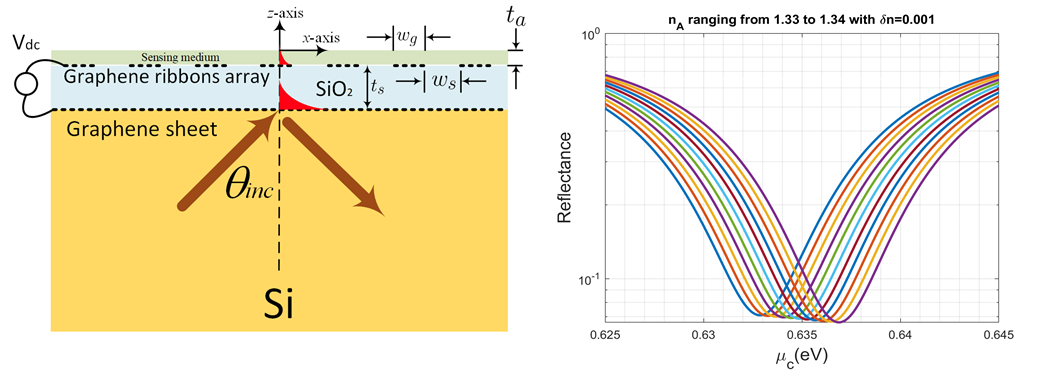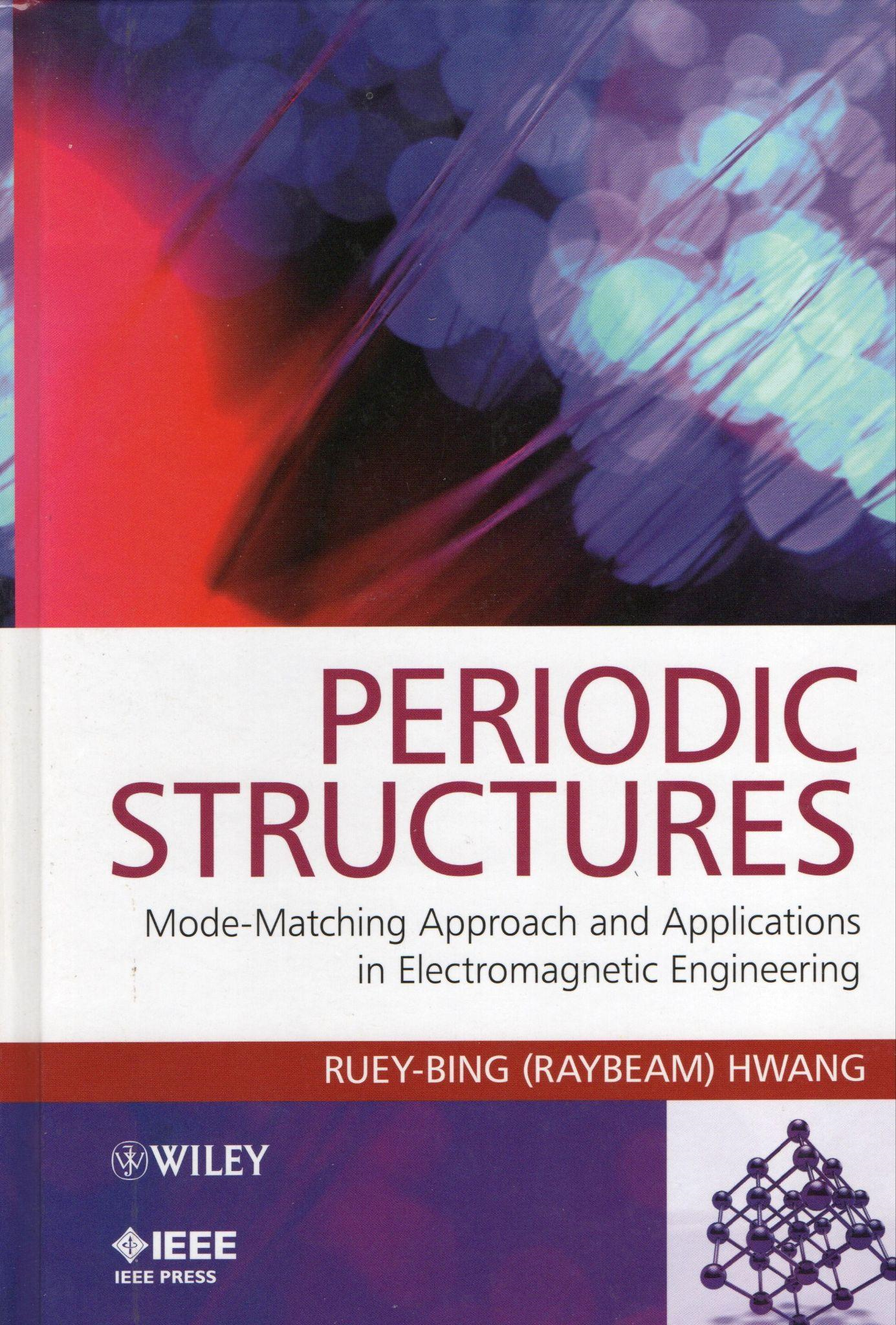
Institute of Communications Engineering, National Yang Ming Chiao Tung University, Hsinchu, Taiwan (2008.08~ present)
National Chung-Shan Institute of Science and Technology
2018.03~2019.04
Institute of Communications Engineering, National Chiao Tung University, Hsinchu, Taiwan (2013~ 2015)
Department of Communications Engineering, National Chiao Tung University, Hsinchu, Taiwan (2005.08~ 2008.07)
Department of Communications Engineering, National Chiao Tung University, Hsinchu, Taiwan (2004.08~ 2005.07)
Periodic Structures: Mode-Matching Approach and Applications in Electromagnetic Engineering
R.-B. (Raybeam) Hwang

In Periodic Structures, Hwang gives readers a comprehensive understanding of the underlying physics in meta-materials made of periodic structures, providing a rigorous and firm mathematical framework for analyzing their electromagnetic properties. The book presents scattering and guiding characteristics of periodic structures using the mode-matching approach and their applications in electromagnetic engineering.
The book is primarily intended for graduate students in electronic engineering, optics, physics, and applied physics, or researchers working with periodic structures. Advanced undergraduates in EE, optics, applied physics applied math, and materials science who are interested in the underlying physics of meta-materials, will also be interested in this text.
Prof. Hwang has made important contributions to exploring the physics of wave processes involved in metamaterials and photonic crystals, both made of periodic structures. His intensive and extensive research in the guiding and scattering characteristics of electromagnetic waves in 1D, 2D, and 3D periodic structures has enabled the clarification of extraordinary phenomena, such as the complex modes in the slanted stop band, the properties of negative group velocity, and the leaky-wave characteristic of a photonic crystal waveguide, all of which were carefully calculated and methodically discussed by Prof. Hwang. Relevant publications are listed from [1] to [3] in Selected Publications. Additionally, his theoretical research on the scattering characteristic of a 2D periodic impedance surface consisting of the isotropic and anisotropic ones has been successfully conducted and applied to the design of meta-surface and pla- nar absorber [4, 5].
Additionally, [6] was the first ever report in which the rigorous mode-matching approach was employed for solving the scattering characteristics of a 2D graphene-based gratings. The general model of graphene tensor conductivity (due to magneto-static field biased or spatial dispersion) was taken into account to derive the input-output relation of the single graphene grating; thus, the scattering characteristics of the overall structure consisting of multiple planar 2D graphene gratings can be obtained by using the building block approach.
In recent years, he devoted to the research of metasurface made of graphene ribbons array. To mention a few: the modified Fourier Modal Method based on the local basis functions incorporating edge conditions was developed to highly improve the numerical convergence in the scattering analysis of graphene strips array [7]. Specifically, a surface plasmon resonance (SPR) sensor based on gate-controlled periodic graphene ribbons array was developed [8]. Different from the conventional methods by monitoring reflectivity variations with respect to incident angle or wavelength, this approach measures the change in SPR curve against the variation of graphene chemical potential (via dynamically tuning the gate voltage) at both fixed incident angle and wave- length without the need of rotating mirror, tunable filter or spectrometer for angular or wavelength interrogation.
[1] Ruey Bing Hwang, "Relations between the reflectance and band structure of 2-D metallodielectric electromagnetic crystals," in IEEE Transactions on Antennas and Propagation, vol. 52, no. 6, pp. 1454-1464, June 2004 (Link)
[2] Ruey Bing Hwang, "Negative group velocity and anomalous transmission in a one-dimensionally periodic waveguide," in IEEE Transactions on Antennas and Propagation, vol. 54, no. 2, pp. 755-760, Feb. 2006 (Link)
[3] R. Hwang, "Surface waves and volume wavesin a photonic crystal slab", Optics Express, vol. 15, no. 13, pp. 7913-7921, Jun. 2007 (Link)
[4] Binary meta-hologram for a reconfigurable holographic metamate- rial antenna, R.-B. Hwang , Scientific Reports, 2020 (Link)
[5] Ruey Bing Hwang, "Scattering characteristics of two-dimensionally periodic impedance surface," in IEEE Transactions on Antennas and Propagation, vol. 48, no. 10, pp. 1521-1527, Oct. 2000 (Link)
[6] R.-B. Hwang, "Rigorous formulation of the scattering of plane waves by 2-D Graphene-based gratings: Out-of-plane incidence," in IEEE Transactions on Antennas and Propagation, vol. 62, no. 9, pp. 4736-4745, Sept. 2014 (Link)
[7] Highly improved convergence approach incorporating edge condi- tions for scattering analysis of graphene gratings, R.-B. Hwang , Scientific Reports, 2020 (Link)
[8] A theoretical design of evanescent wave biosensors based on gate- controlled graphene surface plasmon resonance, R.-B. Hwang , Scientific Reports, 2021 (Link)
A theoretical design of evanescent wave biosensors based on gate-controlled graphene surface plasmon resonance
This research presents the theoretical design and electro- magnetic full-wave numerical verification of a surface plasmon resonance (SPR) sensor based on a gate-con- trolled periodic array of graphene ribbons, shown in Fig. 1(a) and (b).
Unlike traditional methods that monitor reflectivity variations with respect to incident angle or wavelength, this approach measures the change in the surface plasmon reso- nance (SPR) curve at a fixed incident angle and wavelength against the variation of graphene chemical potential (achieved by dynamically tuning the gate voltage) shown in Fig. 2 and Fig. 3, eliminating the need for rotating mirrors, tunable filters, or spectrometers for angular or wave- length interrogation.
It is interesting to observe that this non-metallic biosensor can detect the redistribution (lateral shift) of analytes modeled as a periodic array of discrete sensing media, such as live viruses.
Theoretical calculations show that the sensitivities for analyte refractive index (RI) equal to 1.33, 1.34, 1.35, and 1.36 are 36,401.1 mV/RIU, 40,676.5 mV/RIU, 40,918.2 mV/ RIU, and 41,160 mV/RIU, respectively, with correspond- ing figures of merit (1/RIU) of 21.84, 24, 23.74, and 23.69.

The left figure illustrates the 2D structure of the biosensor for electromagnetic full-wave simulation. The simulation involves a TM-polarized plane wave that is obliquely incident from a dense medium (i.e., the substrate) to a less dense medium (the slice) to generate an evanescent wave. The sensing medium to be detected is positioned above the graphene ribbon array.
The right figure depicts the plots of the reflectance versus chemical potential. The curves from left to right represent the reflectance of various analyte refractive indices ranging from 1.33 to 1.34 with a step size of ΔnA = 0.001. As shown in this figure, the shift in the SPR curve is clear enough to observe changes in the refractive index.
Prof. Hwang has made important contributions to exploring the physics of wave processes involved in metamaterials and photonic crystals, both made of periodic structures. His intensive and extensive research in the guiding and scattering characteristics of electromagnetic waves in 1D, 2D, and 3D periodic structures has enabled the clarification of extraordinary phenomena, such as the complex modes in the slanted stop band, the properties of negative group velocity, and the leaky-wave characteristic of a photonic crystal waveguide, all of which were carefully calculated and methodically discussed by Prof. Hwang. Relevant publications are listed from [1] to [3] in Selected Publications. Additionally, his theoretical research on the scattering characteristic of a 2D periodic impedance surface consisting of the isotropic and anisotropic ones has been successfully conducted and applied to the design of meta-surface and planar absorber [4, 5].
Additionally, [6] was the first ever report in which the rigorous mode-matching approach was employed for solving the scattering characteristics of a 2D graphene-based gratings. The general model of graphene tensor conductivity (due to magneto-static field biased or spatial dispersion) was taken into account to derive the input-output relation of the single graphene grating; thus, the scattering characteristics of the overall structure consisting of multiple planar 2D graphene gratings can be obtained by using the building block approach.
In recent years, he devoted to the research of metasurface made of graphene ribbons array. To mention a few: the modified Fourier Modal Method based on the local basis functions incorporating edge conditions was developed to highly improve the numerical convergence in the scattering analysis of graphene strips array [7]. Specifically, a surface plasmon resonance (SPR) sensor based on gate-controlled periodic graphene ribbons array was developed [8]. Different from the conventional methods by monitoring reflectivity variations with respect to incident angle or wavelength, this approach measures the change in SPR curve against the variation of graphene chemical potential (via dynamically tuning the gate voltage) at both fixed incident angle and wave- length without the need of rotating mirror, tunable filter or spectrometer for angular or wavelength interrogation.
[1] Ruey Bing Hwang, "Relations between the reflectance and band structure of 2-D metallodielectric electromagnetic crystals," in IEEE Transactions on Antennas and Propagation, vol. 52, no. 6, pp. 1454-1464, June 2004 (Link)
[2] Ruey Bing Hwang, "Negative group velocity and anomalous transmission in a one-dimensionally periodic waveguide," in IEEE Transactions on Antennas and Propagation, vol. 54, no. 2, pp. 755-760, Feb. 2006 (Link)
[3] R. Hwang, "Surface waves and volume wavesin a photonic crystal slab", Optics Express, vol. 15, no. 13, pp. 7913-7921, Jun. 2007 (Link)
[4] Binary meta-hologram for a reconfigurable holographic metamate- rial antenna, R.-B. Hwang , Scientific Reports, 2020 (Link)
[5] Ruey Bing Hwang, "Scattering characteristics of two-dimensionally periodic impedance surface," in IEEE Transactions on Antennas and Propagation, vol. 48, no. 10, pp. 1521-1527, Oct. 2000 (Link)
[6] R.-B. Hwang, "Rigorous formulation of the scattering of plane waves by 2-D Graphene-based gratings: Out-of-plane incidence," in IEEE Transactions on Antennas and Propagation, vol. 62, no. 9, pp. 4736-4745, Sept. 2014 (Link)
[7] Highly improved convergence approach incorporating edge condi- tions for scattering analysis of graphene gratings, R.-B. Hwang , Scientific Reports, 2020 (Link)
[8] A theoretical design of evanescent wave biosensors based on gate- controlled graphene surface plasmon resonance, R.-B. Hwang , Scientific Reports, 2021 (Link)
